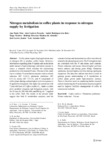Use este identificador para citar ou linkar para este item:
http://www.alice.cnptia.embrapa.br/alice/handle/doc/1021311Registro completo de metadados
| Campo DC | Valor | Idioma |
|---|---|---|
| dc.contributor.author | PAULA NETO, A. | pt_BR |
| dc.contributor.author | FAVARIN, J. L. | pt_BR |
| dc.contributor.author | REIS, A. R. dos | pt_BR |
| dc.contributor.author | TEZOTTO, T. | pt_BR |
| dc.contributor.author | ALMEIDA, R. E. M. de | pt_BR |
| dc.contributor.author | LAVRES JUNIOR, J. | pt_BR |
| dc.contributor.author | GALLO, L. A. | pt_BR |
| dc.date.accessioned | 2015-08-04T11:11:11Z | pt_BR |
| dc.date.available | 2015-08-04T11:11:11Z | pt_BR |
| dc.date.created | 2015-08-04 | pt_BR |
| dc.date.issued | 2015 | pt_BR |
| dc.identifier.citation | Theoretical and Experimental Plant Physiology, v. 27, n. 1, p. 41-50, Mar. 2015. | pt_BR |
| dc.identifier.uri | http://www.alice.cnptia.embrapa.br/alice/handle/doc/1021311 | pt_BR |
| dc.description | Coffee plants require high application rates of nitrogen (N) to produce coffee beans. However, information regarding plant N uptake and assimilation under intensive high-technology cultivation systems is scarce, a situation which restrains the maximizing productivity with minimal N rates. The aim of this study was to evaluate N assimilation enzymes such as nitrate reductase (EC 1.6.6.1), glutamine synthetase (EC 6.3.1.2), urease (EC 3.5.1.5), and N compounds of coffee plants during a phenological cycle in response to N applied by fertigation. Our study was carried out with 7-year-old trees of Coffea arabica L., under a center pivot sprinkler irrigation and fertigation system, with five N rates (0, 200, 400, 600, and 800 kg ha−1) applied to the coffee field. The results of the present study suggest that both N metabolism enzymes, and the content of nitrate and ammonium in coffee were directly related to the phenological cycle. The N fertigation rates are correlated with the N and amino acid contente. Nitrate reductase and urease showed higher activities before anthesis and during grain filling. Glutamine synthetase showed highest activities during rapid grain expansion. The data also indicate that there is merit in gaining greater understanding of N metabolism in coffee plants grown under high-intensive systems. There is therefore merit in conducting further research on how monitoring the N assimilation enzymes might be used to improve fertilizer management of coffee in commercial orchards. | pt_BR |
| dc.language.iso | eng | eng |
| dc.rights | openAccess | eng |
| dc.title | Nitrogen metabolism in coffee plants in response to nitrogen supply by fertigation. | pt_BR |
| dc.type | Artigo de periódico | pt_BR |
| dc.date.updated | 2017-10-13T11:11:11Z | pt_BR |
| dc.subject.thesagro | Café | pt_BR |
| dc.subject.thesagro | Nitrogênio | pt_BR |
| dc.subject.thesagro | Uréia | pt_BR |
| dc.subject.thesagro | Coffea Arábica | pt_BR |
| dc.subject.nalthesaurus | Fertigation | pt_BR |
| dc.subject.nalthesaurus | Glutamate-ammonia ligase | pt_BR |
| riaa.ainfo.id | 1021311 | pt_BR |
| riaa.ainfo.lastupdate | 2017-10-13 -03:00:00 | pt_BR |
| dc.identifier.doi | 10.1007/s40626-014-0030-2 | pt_BR |
| dc.contributor.institution | ANA PAULA NETO, ESALQ; JOSE LAERCIO FAVARIN, ESALQ; ANDRE RODRIGUES DOS REIS, UNESP; TIAGO TEZOTTO, ESALQ; RODRIGO ESTEVAM MUNHOZ DE ALMEIDA, CNPASA; JOSE LAVRES JUNIOR, CENA; LUIZ ANTONIO GALLO, ESALQ. | pt_BR |
| Aparece nas coleções: | Artigo em periódico indexado (CNPASA)  | |
Arquivos associados a este item:
| Arquivo | Descrição | Tamanho | Formato | |
|---|---|---|---|---|
| CNPASA20151.pdf | 353,89 kB | Adobe PDF |  Visualizar/Abrir |









